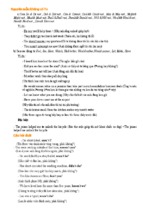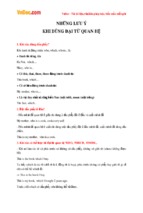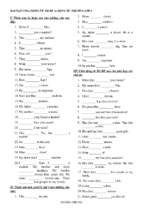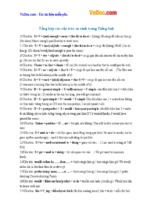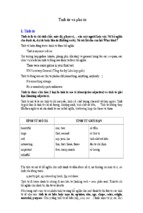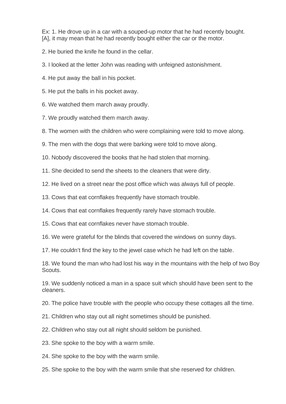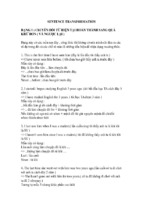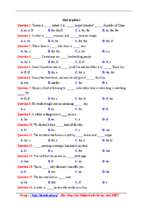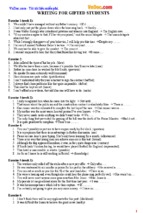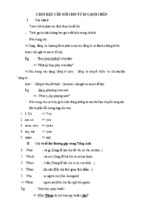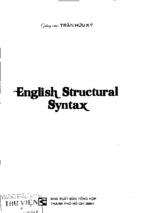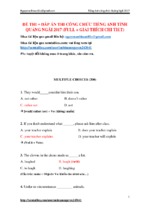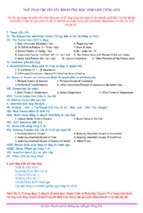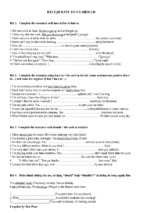Phrasal verbs explanation and dictionary
Phrasal Verbs Definition and Dictionary
Prof. Clifford
1
Grammar notes: Phrasal Verbs Introduction
Prof. Clifford
General information
Phrasal Verbs are verbs followed by what is sometimes called a 'particle'. This 'particle' is either a
preposition or an adverb, or possibly one of each. Most people think it's a preposition.
Don’t worry if it is a prepositions or an adverb. Call them whatever you want. The most important thing is
that you should understand as many phrasal verbs as possible and be able to use them. English people use
them all the time.
Unfortunately there's no easy way of learning them. All I can do here is show the basic uses and types.
Uses of phrasal verbs
We use phrasal verbs in three ways: to describe an action literally.
For example:
He went out of the room.
The neighbours have gone away on holiday.
Sit down and have some tea.
She walked past him without saying a word.
The majority of phrasal verbs are used in this way. All you need to know is what the two words mean when
considered separately. You shouldn't really have any problems here. Or not many to intensify or emphasise
an action.
For example:
You're not going out until you've eaten up your dinner.
It's been pouring down with rain all day.
Don't fill it up completely! I only want a little.
He can add up easily but he can't subtract, multiply or divide.
This way of using phrasal verbs is less common. Sometimes the meaning is literal - the rain pours down and sometimes it isn't - you eat up your dinner. Obviously rain pours down because of gravity. Eating up
your dinner gives us the idea of finishing it completely.
The non-literal uses are a bit difficult to explain and understand. However, because verbs are used in this
way to intensify or emphasise, the general meaning is the same if you just use the verb alone (eat your
dinner, pour with rain, etc).
In other words, you'll have no problem understanding the verbs when you hear them as verbs with a special
meaning.
For example:
I'll look after the children if you want to go out.
I've applied for hundreds of jobs, but they always turn me down.
I had plans to go to university, but they fell through.
Her daughter was run over while playing in the street. With these verbs, knowing what the individual parts
mean doesn't help you to understand. You need to learn the meanings of each verb as a whole.
2
Verb types
There are four types of phrasal verbs. It might help you to know this, but equally it might not. If you find it
confusing, don't worry too much. There are various ways of learning phrasal verbs, and knowing the
specific type is not necessary.
However, knowing what type a verb is can be useful for two reasons. Firstly, it shows you the grammatical
construction, and secondly, some verbs can be more than one type and change meaning accordingly.
The four types do not correspond to the uses I mentioned above. Each particular type can include verbs
with literal and non-literal meanings.
TYPE 1: SUBJECT + VERB + ADVERB + NO OBJECT
TYPE 2: SUBJECT + VERB + ADVERB + OBJECT
TYPE 2: SUBJECT + VERB + OBJECT + ADVERB
TYPE 2: SUBJECT + VERB + OBJECT ( PRONOUN ) + ADVERB
TYPE 3: SUBJECT + VERB + PREPOSITION + OBJECT
TYPE 4 : SUBJECT + VERB + ADVERB + PREPOSITION + OBJECT
3
Type 1 verbs
SUBJECT + VERB + ADVERB + NO OBJECT
These verbs don't have an object.
Examples:
The plane took off two hours late.
He left his wife and children and went away.
There was a horrible smell in the fridge because the chicken had gone off.
All right, I don't know. I give up.
Because there's no object, you don't have to worry about where to put it!
The main difficulty is when a verb can be more than one type. For example, a plane can take off (no object),
but a person can take off a coat (with object). This second example would not be a 'Type 1' verb.
Another problem is when a verb can have more than one meaning but remain the same type. A chicken can
go off, for example, which means it's old and bad and can't be eaten. But a person can go off, too, which
means the same as go away.
Type 2 verbs
SUBJECT + VERB + ADVERB + OBJECT
SUBJECT + VERB + OBJECT + ADVERB
SUBJECT + VERB + OBJECT ( PRONOUN ) + ADVERB
These verbs have an object, and this object can go after the verb or between the two parts of the verb.
Examples:
I must put up those shelves this weekend.
I must put those shelves up this weekend.
I must put them up this weekend.
I must put up them this weekend.
He turned off the TV and went to bed.
He turned the TV off and went to bed.
He turned it off and went to bed.
He turned off it and went to bed.
The council wants to knock down lots of old buildings.
The council wants to knock lots of old buildings down.
The council wants to knock them down.
The council wants to knock down them.
When you don't use a pronoun, it doesn't really matter where you put the object. We generally put the
object where it sounds better.
4
If the object is very long - it could include a relative clause, for example - it will probably sound better after
the verb.
If you use a pronoun, you have to put it between the two words of the verb.
Type 3 verbs
SUBJECT + VERB + PREPOSITION + OBJECT
These verbs have an object, but the object must go after the verb. It doesn't matter whether it's a pronoun or
not.
Examples:
My sister takes after my mother.
My sister takes after her.
My sister takes my mother after.
My sister takes her after.
I'm looking for my credit card. Have you seen it?
I'm looking for it. Have you seen it?
I'm looking my credit card for. Have you seen it?
I'm looking it for. Have you seen it?
Type 4 verbs
SUBJECT + VERB + ADVERB +PREPOSITION + OBJECT
These are the same as Type 3 verbs, but they have three words instead of two. The object must go after the
verb.
Examples:
I'm looking forward to the holidays.
I'm looking forward to them.
Do you get on with your neighbours?
Do you get on with them?
Get on with your work!
Get on with it!
5
Recommendations
There are a number of ways of learning phrasal verbs:
you can learn different meanings according to the main verb, for instance look up, look up to, look down,
look down on, look into, etc.
you can learn different meanings according to the preposition or adverb, for instance let down, turn down,
sit down, put down, write down, etc.
you can learn different verbs used for a particular subject or situation, for instance telephoning: put
through, hold on, hang up, get through, cut off, speak up, etc.
you can learn the different meanings for one particular verb:
the new job didn't work out
she's been working out in the gym all afternoon
I've worked it out and you owe me £75
Personally, I think trying to learn verbs from a list is boring and quite difficult. It's better to learn them for
different situations, then there's more chance that you'll remember them.
Even easier is to treat them as you treat any other vocabulary you learn. Don't think of them as a special
subject that has to be learnt. They're only words! If you find a useful phrasal verb, learn it like you would
learn the word for 'table' or 'ashtray' or anything else.
But make sure you write down the structure. The absolute minimum you need to note down is turn
something off, because then you'll know where the object goes.
Even better would be to note down a couple of sentences using the verb so that you have a context to
remember it in.
Phrasal Verb Websites:
http://www.phrasalverbdemon.com/
http://www.phrasalverbdemon.com/corpus.htm
http://www.englishpage.com/prepositions/phrasaldictionary.html
http://www.englishpage.com/prepositions/prepositions.html
http://www.business-english.com/phrasalverbs/menu.php
6
Phrasal Verb Mini-Dictionary
7
8
9
10
11
12
13
14
15
16
17
18
19
20
- Xem thêm -

